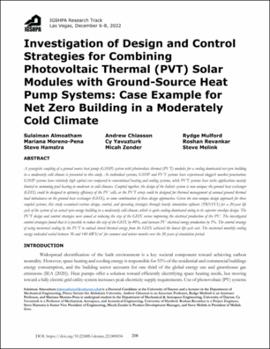| dc.contributor.author | Almoatham, Sulaiman | |
| dc.contributor.author | Chiasson, Andrew | |
| dc.contributor.author | Mulford, Rydge | |
| dc.contributor.author | Moreno-Pena, Mariana | |
| dc.contributor.author | Yavuzturk, Cy | |
| dc.contributor.author | Revankar, Roshan | |
| dc.contributor.author | Hamstra, Steve | |
| dc.contributor.author | Zender, Micah | |
| dc.contributor.author | Melink, Steve | |
| dc.contributor.other | IGSHPA Research Track (2022) | |
| dc.date.accessioned | 2022-12-04T20:53:54Z | |
| dc.date.available | 2022-12-04T20:53:54Z | |
| dc.date.issued | 2022 | |
| dc.identifier | oksd_igshpa_2022_almoatham | |
| dc.identifier.uri | https://hdl.handle.net/11244/336821 | |
| dc.description.abstract | A synergistic coupling of a ground source heat pump (GSHP) system with photovoltaic thermal (PVT) modules for a cooling dominated net-zero building in a moderately cold climate is presented in this study. As individual systems, GSHP and PVT systems have experienced sluggish market penetration; GSHP systems have relatively high capital cost compared to conventional heating and cooling systems, while PVT systems have niche applications mainly limited to swimming pool heating in moderate to cold climates. Coupled together, the design of the holistic system is non-unique; the ground heat exchanger (GHX) could be designed to optimize efficiency of the PV cells, or the PVT array could be designed for thermal management of annual ground thermal load imbalances on the ground heat exchanger (GHX), or some combination of these design approaches. Given the non-unique design approach for these coupled systems, this study examined various design, control, and operating strategies through hourly simulation software (TRNSYS) for a 20-year life cycle of the system of an actual zero-energy building in a moderately cold climate, which is quite cooling-dominated owing to its superior envelope design. The PVT design and control strategies were aimed at reducing the size of the GHX versus improving the electrical production of the PV. The investigated control strategies found that it is possible to reduce the size of the GHX by 40%, and increase PV electrical energy production by 5%. The control strategy of using nocturnal cooling by the PVT to unload stored thermal energy from the GHX achieved the lowest life-cycle cost. The nocturnal monthly cooling energy unloaded varied between 30 and 140 kWh/m2 for summer and winter months over the 20 years of simulation period. | |
| dc.format | application/pdf | |
| dc.language | en_US | en_US |
| dc.publisher | International Ground Source Heat Pump Association | |
| dc.rights | In the Oklahoma State University Library's institutional repository this paper is made available through the open access principles and the terms of agreement/consent between the author(s) and the publisher. The permission policy on the use, reproduction or distribution of the article falls under fair use for educational, scholarship, and research purposes. Contact Digital Resources and Discovery Services at lib-dls@okstate.edu or 405-744-9161 for further information. | |
| dc.title | Investigation of design and control strategies for combining Photovoltaic Thermal (PVT) solar modules with ground-source heat pump systems: Case example for net zero building in a moderately cold climate | |
| osu.filename | oksd_igshpa_2022_almoatham.pdf | |
| dc.identifier.doi | 10.22488/okstate.22.000034 | |
| dc.type.genre | Conference proceedings | |
| dc.type.material | Text | |
